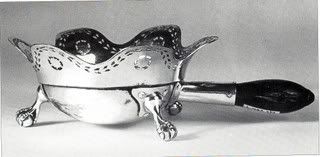It's copper lining is missing. The one pictured was made c.1785.
In the mid 19th century an invention came along that made these obsolete.
I don't think many people in the U.S. know what this was used for. Now, I know we are going to get a few different names and uses for this item. I'm not saying that they are incorrect. I'm just looking for one of it's main uses from the 18th century up until the mid 19th century.

Many people say these have a Dutch origin. That would explain why the few seen in the U.S. were made in New York, a Dutch colony. Spain and at least three of it's former colonies (Mexico, Peru and Argentina) also made them. This Spanish / Dutch connection may be because Spain once occupied Holland until 1648. Spanish ones sometimes have two handles.
Some were also made in Germany, France and Scandinavian countries, frequent traders with the Dutch.
Pat.
.
